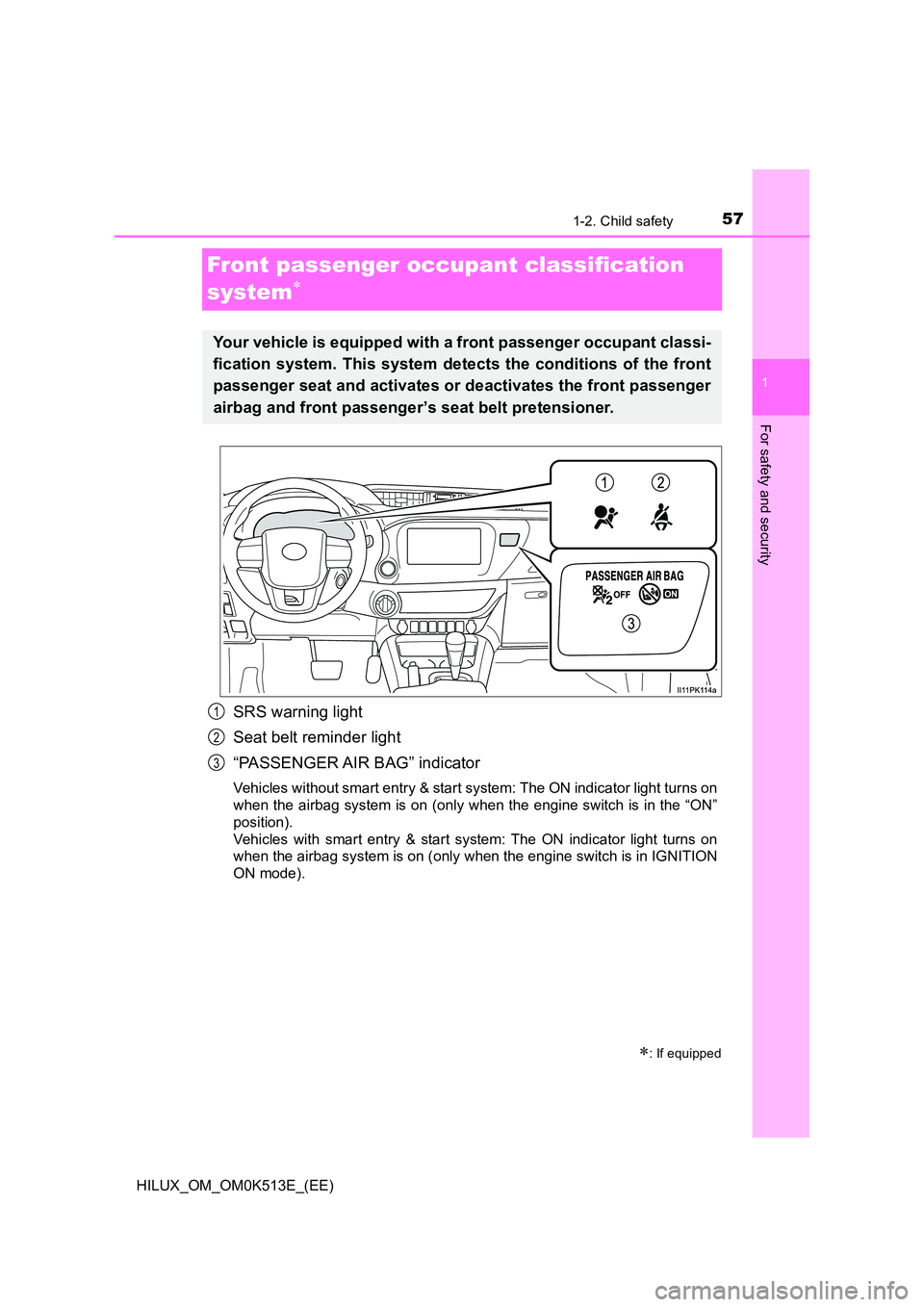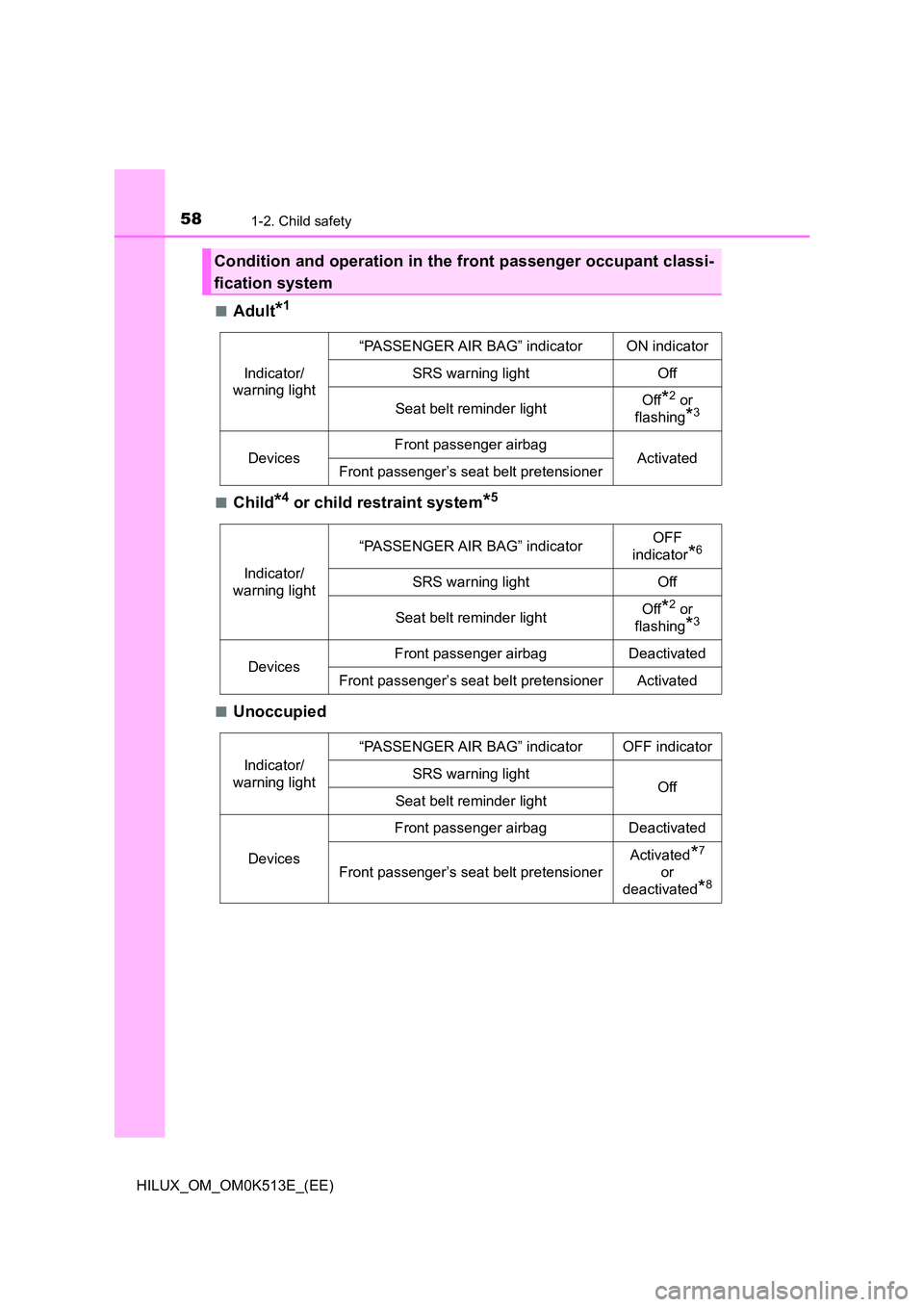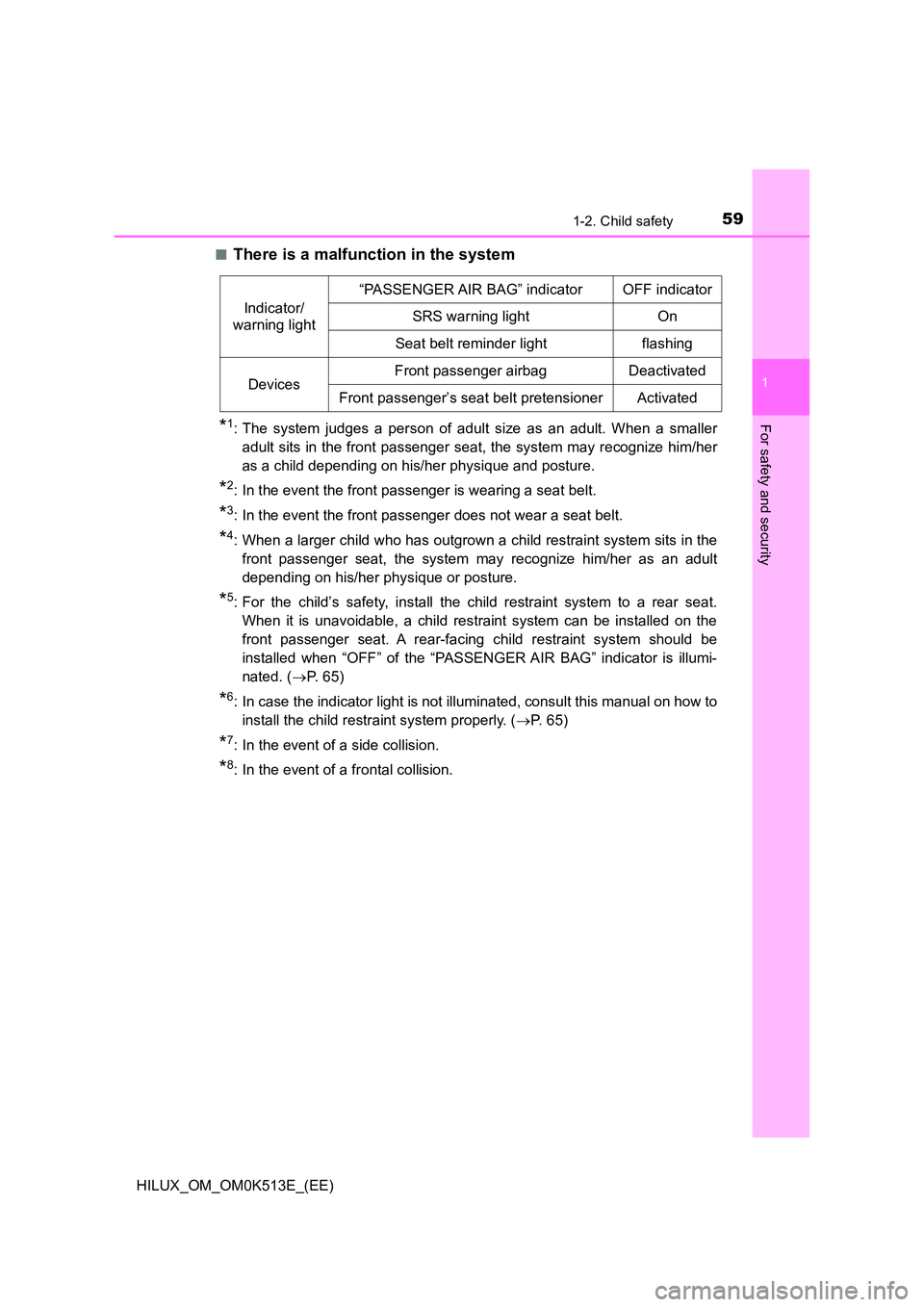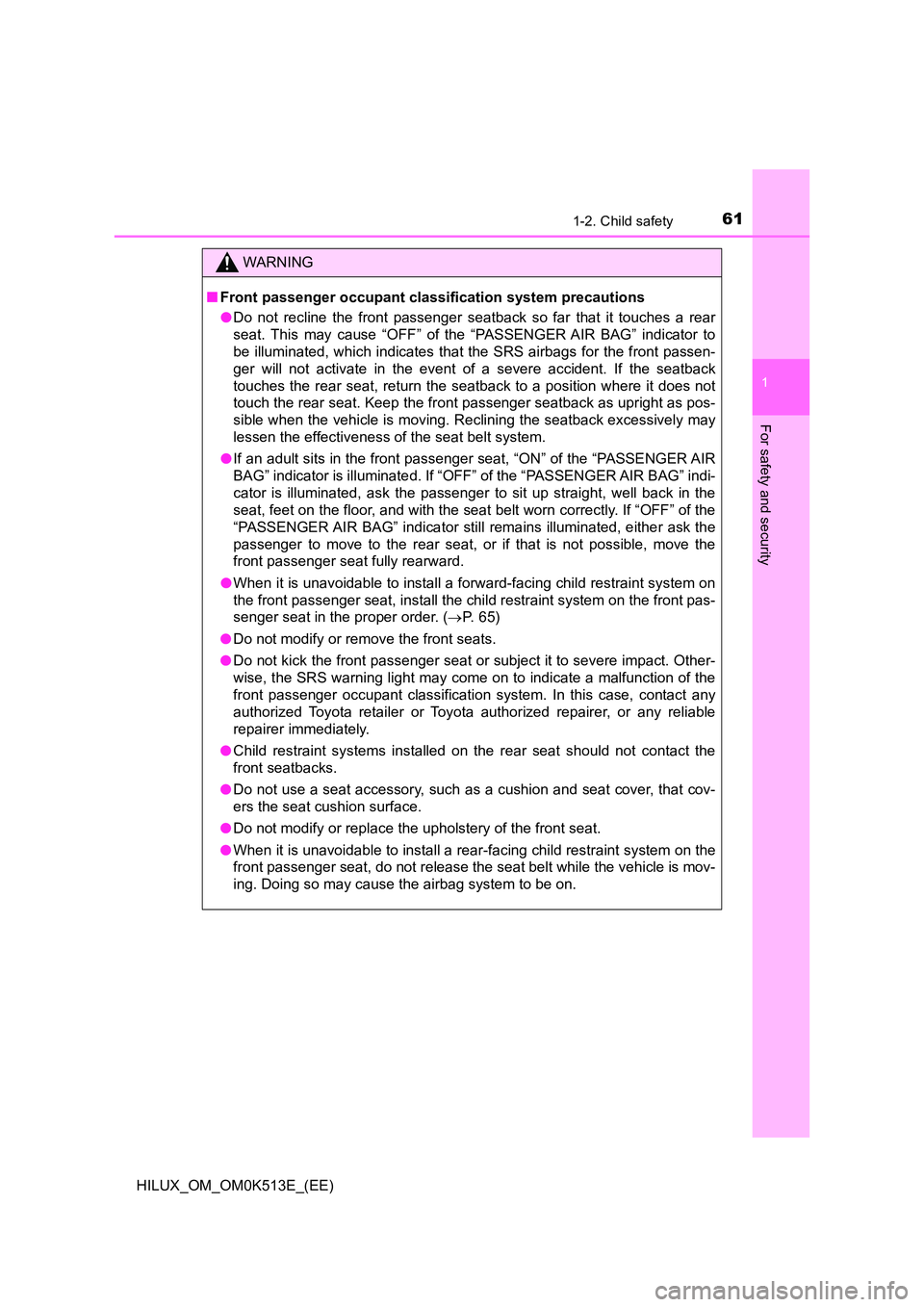2022 TOYOTA HILUX warning light
[x] Cancel search: warning lightPage 49 of 798

471-1. For safe use
1
HILUX_OM_OM0K513E_(EE)
For safety and security
The main SRS airbag system components are shown above. The
SRS airbag system is controlled by the airbag sensor assembly. As
the airbags deploy, a chemical reaction in the inflators quickly fills the
airbags with non-toxic gas to help restrain the motion of the occu-
pants.
WARNING
�Q SRS airbag precautions
Observe the following precautions regarding the SRS airbags.
Failure to do so may cause death or serious injury.
�O The driver and all passengers in the vehicle must wear their seat belts
properly.
The SRS airbags are supplemental devic es to be used with the seat belts.
�O The SRS driver airbag deploys with considerable force, and can cause
death or serious injury especially if the driver is very close to the airbag.
Since the risk zone for the driver’s airbag is the first 50 - 75 mm (2 - 3 in.)
of inflation, placing yourself 250 mm ( 10 in.) from your driver airbag pro-
vides you with a clear margin of safety. This distance is measured from
the center of the steering wheel to your breastbone. If you sit less than
250 mm (10 in.) away now, you can change your driving position in sev-
eral ways:
• Move your seat to the rear as far as you can while still reaching the ped-
als comfortably.
• Slightly recline the back of the seat. Although vehicle designs vary,
many drivers can achieve the 250 mm (10 in.) distance, even with the
driver seat all the way forward, simply by reclining the back of the seat
somewhat. If reclining the back of your seat makes it hard to see the
road, raise yourself by using a firm, non-slippery cushion, or raise the
seat if your vehicle has that feature.
• If your steering wheel is adjustable, tilt it downward. This points the air-
bag toward your chest instead of your head and neck.
The seat should be adjusted as recommended above, while still maintain-
ing control of the foot pedals, steering wheel, and your view of the instru-
ment panel controls.
Page 58 of 798

561-1. For safe use
HILUX_OM_OM0K513E_(EE)
Exhaust gas precautions
Harmful substance to the human body is included in exhaust
gases if inhaled.
WARNING
Exhaust gases include harmful carbon monoxide (CO), which is colorless and
odorless. Observe the following precautions.
Failure to do so may cause exhaust gases enter the vehicle and may lead to
an accident caused by light-headedness, or may lead to death or a serious
health hazard.
�Q Important points while driving
If you smell exhaust gases in the vehicle, open the windows and have the
vehicle inspected at any authorized Toyota retailer or Toyota authorized
repairer, or any reliable repairer as soon as possible.
�Q When parking
�O If the vehicle is in a poorly ventilated area or a closed area, such as a
garage, stop the engine.
�O Do not leave the vehicle with the engine running for a long time.
If such a situation cannot be avoided, park the vehicle in an open space
and ensure that exhaust fumes do not enter the vehicle interior.
�O Do not leave the engine running in an area with snow build-up, or where it
is snowing. If snowbanks build up around the vehicle while the engine is
running, exhaust gases may collect and enter the vehicle.
�Q Exhaust pipe
The exhaust system needs to be checked periodically. If there is a hole or
crack caused by corrosion, damage to a joint or abnormal exhaust noise, be
sure to have the vehicle inspected and repaired by any authorized Toyota
retailer or Toyota authorized repairer, or any reliable repairer.
Page 59 of 798

571-2. Child safety
1
HILUX_OM_OM0K513E_(EE)
For safety and security
Front passenger occupant classification
system
SRS warning light
Seat belt reminder light
“PASSENGER AIR BAG” indicator
Vehicles without smart entry & start system: The ON indicator light turns on
when the airbag system is on (only when the engine switch is in the “ON”
position).
Vehicles with smart entry & start system: The ON indicator light turns on
when the airbag system is on (only when the engine switch is in IGNITION
ON mode).
: If equipped
Your vehicle is equipped with a front passenger occupant classi-
fication system. This system detects the conditions of the front
passenger seat and activates or deactivates the front passenger
airbag and front passenger’s seat belt pretensioner.
1
2
3
Page 60 of 798

581-2. Child safety
HILUX_OM_OM0K513E_(EE)
�QAdult*1
�QChild*4 or child restraint system*5
�QUnoccupied
Condition and operation in the front passenger occupant classi-
fication system
Indicator/
warning light
“PASSENGER AIR BAG” indicator ON indicator
SRS warning light Off
Seat belt reminder light Off*2 or
flashing*3
Devices Front passenger airbag ActivatedFront passenger’s seat belt pretensioner
Indicator/
warning light
“PASSENGER AIR BAG” indicator OFF
indicator*6
SRS warning light Off
Seat belt reminder light Off*2 or
flashing*3
Devices Front passenger airbag Deactivated
Front passenger’s seat belt pretensioner Activated
Indicator/
warning light
“PASSENGER AIR BAG” indicator OFF indicator
SRS warning light OffSeat belt reminder light
Devices
Front passenger airbag Deactivated
Front passenger’s seat belt pretensioner
Activated*7
or
deactivated*8
Page 61 of 798

591-2. Child safety
1
HILUX_OM_OM0K513E_(EE)
For safety and security
�QThere is a malfunction in the system
*1: The system judges a person of adult size as an adult. When a smaller
adult sits in the front passenger seat, the system may recognize him/her
as a child depending on his/her physique and posture.
*2: In the event the front passenger is wearing a seat belt.
*3: In the event the front passenger does not wear a seat belt.
*4: When a larger child who has outgrown a child restraint system sits in the
front passenger seat, the system may recognize him/her as an adult
depending on his/her physique or posture.
*5: For the child’s safety, install the child restraint system to a rear seat.
When it is unavoidable, a child restraint system can be installed on the
front passenger seat. A rear-facing child restraint system should be
installed when “OFF” of the “PASSENGER AIR BAG” indicator is illumi-
nated. ( P. 6 5 )
*6: In case the indicator light is not illuminated, consult this manual on how to
install the child restraint system properly. ( P. 65)
*7: In the event of a side collision.
*8: In the event of a frontal collision.
Indicator/
warning light
“PASSENGER AIR BAG” indicator OFF indicator
SRS warning light On
Seat belt reminder light flashing
Devices Front passenger airbag Deactivated
Front passenger’s seat belt pretensioner Activated
Page 63 of 798

611-2. Child safety
1
HILUX_OM_OM0K513E_(EE)
For safety and security
WARNING
�QFront passenger occupant classification system precautions
�O Do not recline the front passenger seatback so far that it touches a rear
seat. This may cause “OFF” of the “PASSENGER AIR BAG” indicator to
be illuminated, which indicates that the SRS airbags for the front passen-
ger will not activate in the event of a severe accident. If the seatback
touches the rear seat, return the seatback to a position where it does not
touch the rear seat. Keep the front passenger seatback as upright as pos-
sible when the vehicle is moving. Reclining the seatback excessively may
lessen the effectiveness of the seat belt system.
�O If an adult sits in the front passenger seat, “ON” of the “PASSENGER AIR
BAG” indicator is illuminated. If “OFF ” of the “PASSENGER AIR BAG” indi-
cator is illuminated, ask the passenger to sit up straight, well back in the
seat, feet on the floor, and with the seat belt worn correctly. If “OFF” of the
“PASSENGER AIR BAG” indicator still re mains illuminated, either ask the
passenger to move to the rear seat, or if that is not possible, move the
front passenger seat fully rearward.
�O When it is unavoidable to install a forward-facing child restraint system on
the front passenger seat, install the child restraint system on the front pas-
senger seat in the proper order. ( P. 6 5 )
�O Do not modify or remove the front seats.
�O Do not kick the front passenger seat or subject it to severe impact. Other-
wise, the SRS warning light may come on to indicate a malfunction of the
front passenger occupant classification system. In this case, contact any
authorized Toyota retailer or Toyota authorized repairer, or any reliable
repairer immediately.
�O Child restraint systems installed on the rear seat should not contact the
front seatbacks.
�O Do not use a seat accessory, such as a cushion and seat cover, that cov-
ers the seat cushion surface.
�O Do not modify or replace the upholstery of the front seat.
�O When it is unavoidable to install a rear-facing child restraint system on the
front passenger seat, do not release the seat belt while the vehicle is mov-
ing. Doing so may cause the airbag system to be on.
Page 65 of 798

631-2. Child safety
1
HILUX_OM_OM0K513E_(EE)
For safety and security
Vehicles without smart entry &
start system:
Insert the key into the cylinder and
turn to the “OFF” position.
The OFF indicator light turns on
(only when the engine switch is in
the “ON” position).
Vehicles with smart entry & start
system:
Insert the mechanical key into the cylinder and rotate to the “OFF”
position.
The OFF indicator light turns on (only when the engine switch is in
IGNITION ON mode).
�Q “PASSENGER AIR BAG” indicator information
If any of the following problems occur, it is possible that there is a malfunction
in the system. Have the vehicle inspected by any authorized Toyota retailer or
Toyota authorized repairer, or any reliable repairer.
�O Neither “ON” nor “OFF” comes on.
�O The indicator light does not change when the airbag manual on-off switch is
switched to “ON” or “OFF”.
Deactivating the airbag for the front passenger
WARNING
�Q When installing a child restraint system
For safety reasons, always install the child restraint system in a rear seat. In
the event that the rear seat cannot be used, the front seat can be used as
long as the airbag manual on-off system is set to “OFF”.
If the airbag manual on-off system is left on, the strong impact of the airbag
deployment (inflation) may cause serious injury or even death.
�Q When a child restraint system is not installed on the front passenger
seat
Ensure that the airbag manual on-off system is set to “ON”.
If it is left off, the airbag may not deploy in the event of an accident, which
may result in serious injury or even death.
Page 103 of 798

1011-3. Emergency assistance
1
HILUX_OM_OM0K513E_(EE)
For safety and security
WARNING
�QWhen the Emergency Call may not be made
�O It may not be possible to make Emergency Calls in any of the following sit-
uations. In such cases, report to emergency services provider (112 system
etc.) by other means such as nearby public phones.
• Even when the vehicle is in the cellular phone service area, it may be
difficult to connect to the eCall control center if the reception is poor or
the line is busy. In such cases, even though the system attempts to con-
nect to the eCall control center, you may not be able to connect to the
eCall control center to make Emergency Calls and contact emergency
services.
• When the vehicle is out of the cellular phone service area, the Emer-
gency Calls cannot be made.
• When any related equipment (such as the “SOS” button panel, indicator
lights, microphone, speaker, DCM, antenna, or any wires connecting
the equipment) is malfunctioning, damaged or broken, the Emergency
Call cannot be made.
• During an Emergency Call, the system makes repeated attempts to
connect to the eCall control center. However, if it cannot connect to the
eCall control center due to poor radio wave reception, the system may
not be able to connect to the cellular network and the call may finish
without connecting. The red indicator light will blink for approximately 30
seconds to indicate this disconnection.
�O If the battery’s voltage decreases or there is a disconnection, the system
may not be able to connect to the eCall control center.
�O The Emergency Call system might not work outside of EU area, depend-
ing on the available infrastructure in the country.
�Q When the Emergency Call system is replaced with a new one
The Emergency Call system should be registered. Contact any authorized
Toyota retailer or Toyota authorized repairer, or any reliable repairer.